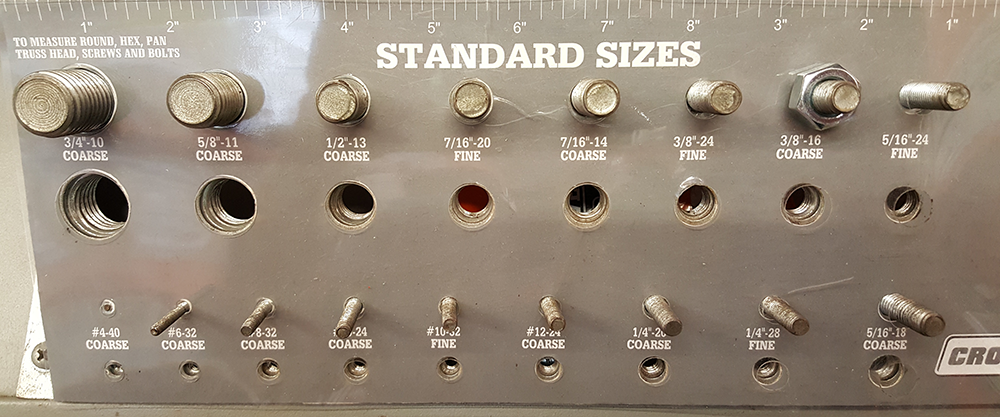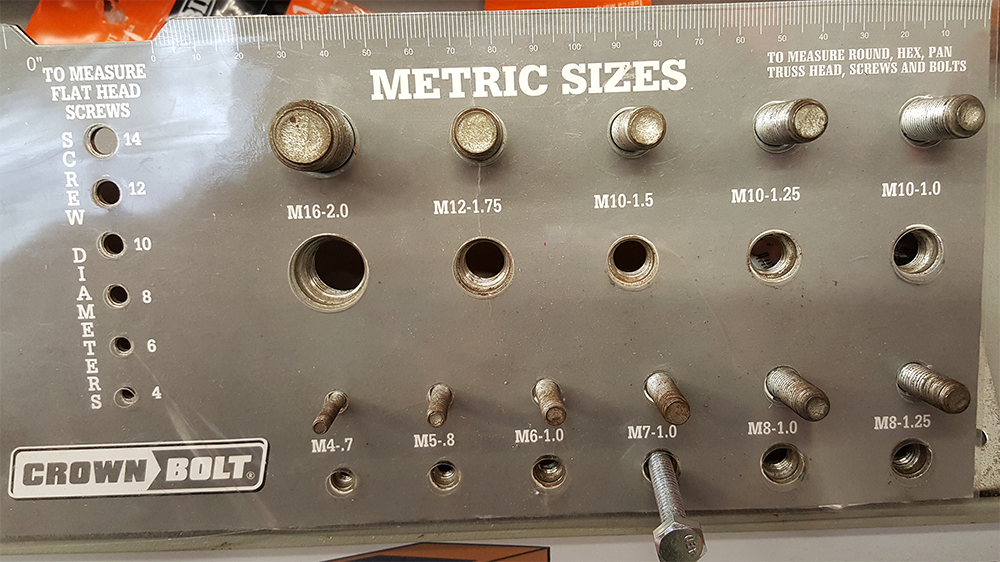2.4: Threaded Fasteners, Drivers, Pliers and Wrenches
- Page ID
- 2312
\( \newcommand{\vecs}[1]{\overset { \scriptstyle \rightharpoonup} {\mathbf{#1}} } \)
\( \newcommand{\vecd}[1]{\overset{-\!-\!\rightharpoonup}{\vphantom{a}\smash {#1}}} \)
\( \newcommand{\id}{\mathrm{id}}\) \( \newcommand{\Span}{\mathrm{span}}\)
( \newcommand{\kernel}{\mathrm{null}\,}\) \( \newcommand{\range}{\mathrm{range}\,}\)
\( \newcommand{\RealPart}{\mathrm{Re}}\) \( \newcommand{\ImaginaryPart}{\mathrm{Im}}\)
\( \newcommand{\Argument}{\mathrm{Arg}}\) \( \newcommand{\norm}[1]{\| #1 \|}\)
\( \newcommand{\inner}[2]{\langle #1, #2 \rangle}\)
\( \newcommand{\Span}{\mathrm{span}}\)
\( \newcommand{\id}{\mathrm{id}}\)
\( \newcommand{\Span}{\mathrm{span}}\)
\( \newcommand{\kernel}{\mathrm{null}\,}\)
\( \newcommand{\range}{\mathrm{range}\,}\)
\( \newcommand{\RealPart}{\mathrm{Re}}\)
\( \newcommand{\ImaginaryPart}{\mathrm{Im}}\)
\( \newcommand{\Argument}{\mathrm{Arg}}\)
\( \newcommand{\norm}[1]{\| #1 \|}\)
\( \newcommand{\inner}[2]{\langle #1, #2 \rangle}\)
\( \newcommand{\Span}{\mathrm{span}}\) \( \newcommand{\AA}{\unicode[.8,0]{x212B}}\)
\( \newcommand{\vectorA}[1]{\vec{#1}} % arrow\)
\( \newcommand{\vectorAt}[1]{\vec{\text{#1}}} % arrow\)
\( \newcommand{\vectorB}[1]{\overset { \scriptstyle \rightharpoonup} {\mathbf{#1}} } \)
\( \newcommand{\vectorC}[1]{\textbf{#1}} \)
\( \newcommand{\vectorD}[1]{\overrightarrow{#1}} \)
\( \newcommand{\vectorDt}[1]{\overrightarrow{\text{#1}}} \)
\( \newcommand{\vectE}[1]{\overset{-\!-\!\rightharpoonup}{\vphantom{a}\smash{\mathbf {#1}}}} \)
\( \newcommand{\vecs}[1]{\overset { \scriptstyle \rightharpoonup} {\mathbf{#1}} } \)
\( \newcommand{\vecd}[1]{\overset{-\!-\!\rightharpoonup}{\vphantom{a}\smash {#1}}} \)
\(\newcommand{\avec}{\mathbf a}\) \(\newcommand{\bvec}{\mathbf b}\) \(\newcommand{\cvec}{\mathbf c}\) \(\newcommand{\dvec}{\mathbf d}\) \(\newcommand{\dtil}{\widetilde{\mathbf d}}\) \(\newcommand{\evec}{\mathbf e}\) \(\newcommand{\fvec}{\mathbf f}\) \(\newcommand{\nvec}{\mathbf n}\) \(\newcommand{\pvec}{\mathbf p}\) \(\newcommand{\qvec}{\mathbf q}\) \(\newcommand{\svec}{\mathbf s}\) \(\newcommand{\tvec}{\mathbf t}\) \(\newcommand{\uvec}{\mathbf u}\) \(\newcommand{\vvec}{\mathbf v}\) \(\newcommand{\wvec}{\mathbf w}\) \(\newcommand{\xvec}{\mathbf x}\) \(\newcommand{\yvec}{\mathbf y}\) \(\newcommand{\zvec}{\mathbf z}\) \(\newcommand{\rvec}{\mathbf r}\) \(\newcommand{\mvec}{\mathbf m}\) \(\newcommand{\zerovec}{\mathbf 0}\) \(\newcommand{\onevec}{\mathbf 1}\) \(\newcommand{\real}{\mathbb R}\) \(\newcommand{\twovec}[2]{\left[\begin{array}{r}#1 \\ #2 \end{array}\right]}\) \(\newcommand{\ctwovec}[2]{\left[\begin{array}{c}#1 \\ #2 \end{array}\right]}\) \(\newcommand{\threevec}[3]{\left[\begin{array}{r}#1 \\ #2 \\ #3 \end{array}\right]}\) \(\newcommand{\cthreevec}[3]{\left[\begin{array}{c}#1 \\ #2 \\ #3 \end{array}\right]}\) \(\newcommand{\fourvec}[4]{\left[\begin{array}{r}#1 \\ #2 \\ #3 \\ #4 \end{array}\right]}\) \(\newcommand{\cfourvec}[4]{\left[\begin{array}{c}#1 \\ #2 \\ #3 \\ #4 \end{array}\right]}\) \(\newcommand{\fivevec}[5]{\left[\begin{array}{r}#1 \\ #2 \\ #3 \\ #4 \\ #5 \\ \end{array}\right]}\) \(\newcommand{\cfivevec}[5]{\left[\begin{array}{c}#1 \\ #2 \\ #3 \\ #4 \\ #5 \\ \end{array}\right]}\) \(\newcommand{\mattwo}[4]{\left[\begin{array}{rr}#1 \amp #2 \\ #3 \amp #4 \\ \end{array}\right]}\) \(\newcommand{\laspan}[1]{\text{Span}\{#1\}}\) \(\newcommand{\bcal}{\cal B}\) \(\newcommand{\ccal}{\cal C}\) \(\newcommand{\scal}{\cal S}\) \(\newcommand{\wcal}{\cal W}\) \(\newcommand{\ecal}{\cal E}\) \(\newcommand{\coords}[2]{\left\{#1\right\}_{#2}}\) \(\newcommand{\gray}[1]{\color{gray}{#1}}\) \(\newcommand{\lgray}[1]{\color{lightgray}{#1}}\) \(\newcommand{\rank}{\operatorname{rank}}\) \(\newcommand{\row}{\text{Row}}\) \(\newcommand{\col}{\text{Col}}\) \(\renewcommand{\row}{\text{Row}}\) \(\newcommand{\nul}{\text{Nul}}\) \(\newcommand{\var}{\text{Var}}\) \(\newcommand{\corr}{\text{corr}}\) \(\newcommand{\len}[1]{\left|#1\right|}\) \(\newcommand{\bbar}{\overline{\bvec}}\) \(\newcommand{\bhat}{\widehat{\bvec}}\) \(\newcommand{\bperp}{\bvec^\perp}\) \(\newcommand{\xhat}{\widehat{\xvec}}\) \(\newcommand{\vhat}{\widehat{\vvec}}\) \(\newcommand{\uhat}{\widehat{\uvec}}\) \(\newcommand{\what}{\widehat{\wvec}}\) \(\newcommand{\Sighat}{\widehat{\Sigma}}\) \(\newcommand{\lt}{<}\) \(\newcommand{\gt}{>}\) \(\newcommand{\amp}{&}\) \(\definecolor{fillinmathshade}{gray}{0.9}\)Threaded Fasteners
Selecting the appropriate fastener for a particular application involves considering many factors to include: functionality, strength and durability, exposure to natural elements, and aesthetics.While most bolts and many screws are designed for the head to press firmly against flat surfaces of materials and parts, screws with tapered or bugle style heads are manufactured to be countersunk even with or below material surfaces. Screws, bolts and other threaded fastener accessories are normally made of brass; or mild, hardened or stainless steel; or plastics in some designed for lighter and cosmetic applications. In many cases, threaded fasteners are treated with processes such as galvanization, electroplated phosphate, or chemical primers such as zinc oxide.
Screws are taper tipped and threaded in a manner that helps wood, or other materials, draw together as the screw is inserted. They are used in place of nails when stronger joining power is needed. A screw makes its own thread pattern in the material. Screw head shapes (slotted, pan, hex, oval, flat) vary according to the application. Also the slots or drive types of screws are available in a wide variety (slotted, Phillips, Robertson, square, Pozidrive®, etc.).
Query \(\PageIndex{1}\)
Bolts are male threaded fasteners that require a female threaded counterpart (a “nut” or a threaded hole in a material) in order to secure themselves. Nuts and bolts allow for future disassembly and when used with flat and locking style washers, provide strong mechanical bonds and stability. These threaded fasteners are available in coarse and fine thread configurations which are recognized by the amount of threads per inch (tpi) in SAE fasteners and by pitch in metric fasteners. Cap head and stove type bolts are also rated by their hardness or shear strength. Various cast or embossed markings can be found on the head of these kinds of bolts, with each type of marking symbolizing a bolt’s capacity.


Specialty Anchors
Specialty anchors such as eye hooks, J-hooks for drywall, masonry, tile, wood, and other materials are available in both screw and bolt designs.
Tap and Die sets can be used to thread materials to accept another fastener. Taps are tools made to cut female threads while Dies are tools designed to cut male threads on round stock materials. It is important that the drilled hole size for tapping, or the diameter of the material to be threaded with a die, be of a specific size and tolerance so that the final threaded product fits properly. Taps and dies are also individually available in each machine fastener diameter and thread count.
Query \(\PageIndex{1}\)
All of the fasteners listed above require tool to tighten when assembling projects and loosen them when disassembly is required. Drivers, pliers and wrenches facilitate the assembly of items with threaded objects such as nuts, bolts, screws, plumbing and electrical fittings and pipes. Various styles of pliers can also be used to cut, bend, pull and crimp materials and mechanical fittings. While the proper selection of tools for particular fastener or fitting will result in easier and more rapid assembly and disassembly of projects, improper tool selection may result in material, parts, and tool damage, lost time, and possible injury.
Drivers
Query \(\PageIndex{1}\)
Pliers
Pliers are primarily used to grip objects that utilize leverage. Different configurations of the jaw are also used to grip, turn, pull, crimp and sometimes cut a variety of things. Many types are commonly identified by a manufacturer brand or model name and used by workers in multiple construction trades fields (Channellock® is a registered trademark for a manufacturer that makes numerous styles of tools, however tongue and groove pliers are commonly referred to as channel-lock pliers).
Query \(\PageIndex{1}\)
Wrenches
Wrenches can be used to turn bolts, nuts, or other hard to turn items. Wrenches provide excellent leverage compared to pliers, and most are designed to fit specific sized fasteners. The choice of an appropriate wrench depends upon the torque or leverage required to perform a function or the design of a fastener. The wrong choice of a wrench for a task can cause slipping of the wrench, damage materials and parts, and result in bodily injury. As nuts, bolts, and fasteners are offered in standardized fractional (SAE (Society of Automotive Engineers) and metric (millimeter or mm.) sizes, most wrenches are designed to fit hexagonal (six-sided) or hex fasteners and mechanical fittings. Wrenches can be purchased either individually or in sets based on style or combinations of styles.
Query \(\PageIndex{1}\)
TOOL TIPS:
- Only use bits and sockets rated for impact use with impact drivers and impact wrenches. Non-impact tools are made of materials that can crack, break, or shatter when used with impact tools.
- Apply a penetrating oil according to manufacturer directions to rusted fasteners prior to trying to loosen them.
- “Stuck” or rusted nuts, bolts, and screws can sometimes be freed by striking them sharply on the head with a steel punch.
- Traditional fasteners turn in a clockwise direction to tighten and counter-clockwise to loosen. Fasteners of this design are also known as “right-hand” threaded fasteners.
- Specialty fasteners required for certain mechanical applications turn counter-clockwise to tighten and clockwise to loosen. These are also referred to as “left-hand” threaded fasteners.


